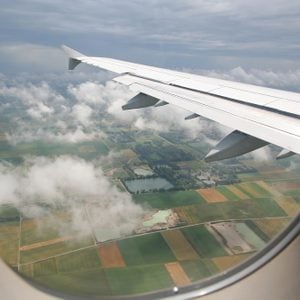This Is Why Airplane Windows Are Round
Updated: May 16, 2022

If you flew before the 1950s and got a window seat, you'd look out an airplane window that was a completely different shape than it is today. So, why did it change?
Whether you love your window seat or prefer to stay far away and forget you’re in flight, you’ve no doubt noticed that all airplane windows are round—it’s a pretty standard airplane fact. It’s something you probably haven’t questioned because it’s just the way it is—just like you probably haven’t questioned what happens when you flush an airplane toilet or what certain airplane sounds are.
But is there a reason an airplane window is round? Does the shape actually help the plane stay up, or are the curved edges just more aesthetically pleasing? After you get your answer to this airplane question, find answers to other airplane questions, like why “airplane” is also spelled “aeroplane,” how high airplanes actually fly, and what’s up with those rear-facing airplane seats.
Airplane windows used to be square
Turns out, airplane windows were not always round—they used to be square. They were square up until the 1950s, during a time when planes flew slower and lower. So, why did these airplane features change their shape entirely?
Airplane windows were made round for safety
Willis Orlando, Product Operations Specialist at Scott’s Cheap Flights, says the round shape, while gentle on the eyes, is for a lot more than aesthetic purposes. “Rounded corners are designed to help evenly distribute the pressure exerted on the window, reducing the likelihood of a window cracking under changing air pressure,” Orlando explains. By the way, this is why it’s so cold on airplanes.
As flying became more popular, airlines began to fly at higher altitudes to cut costs (there’s less drag up there, which limits unnecessary fuel use). The planes themselves also had to be increasingly pressurized, increasing the pressure difference between the inside and outside of the plane and causing more stress buildup.
That’s when square windows began to prove deadly. In 1953 and 1954, three separate planes—all de Havilland Comets, the first jet airliner—disintegrated in midair because of stress concentrates caused by the sharp edges of their windows. The analysis of the crashes, and the similar injuries on the passengers, demonstrated that “metal fatigue failure”—originating from the corners of the windows—had brought the planes down. This led to the oval design you see today, since stress could flow more evenly around a round window rather than building up at the corners of a square one. With this new and improved shape, stress can flow smoothly, and we can fly safely.
So next time you’re looking out an airplane window, be very grateful for their round shape! Next, read up on how airplane Wi-Fi and airplane mode actually work.
Sources:
- Willis Orlando, Product Operations Specialist at Scott’s Cheap Flights
- Aerotime: “Why Airplane Windows Are Round?”
- Real Engineering on YouTube: “Why are plane windows round?”


